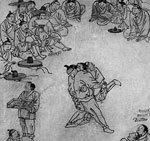Taekwondo 태권도Taekwondo Preschool
Korean martial arts are military practices and methods which have their place in the history of Korea but have been adapted for use by both military and non-military personnel as a method of personal growth or recreation.
Ssang geom 쌍검 雙劍 (twin-swords)
The history of the sword (Korean geom 검; 劍) in the Korean Peninsula begins with imports via Bronze Age in the mid 1st millennium BCE. Native production of Bronze and Iron swords appears to pick up beginning in the mid 1st millennium CE
Korea had its separate sword industry and a native tradition of Korean swordsmanship during the Joseon Dynasty (15th to 19th centuries). This tradition was eclipsed by the Japanese occupation of Korea (1910-1945). Since the later 20th century, there have been efforts towards reviving the lost arts of Korean sword-making and swordsmanship.
Elements of the Korean sword include: geomjip or scabbard, most often of lacquer; hyuljo or fuller (most genuine Korean swords didn't have a fuller); hwando magi or collar; ho in or collar; kodeungi or hand guard; a ring-design pommel; tassels; a round and wide designed sword guard, or a straight lotus design.
- Geom is the generic term for "sword", but more specifically also refers to a shorter straight-blade, double-edged sword with a somewhat blunted tip distinguishes this weapon from its Chinese counterpart, the jian. As a badge of status rather than a weapon, the Geom was often heavily decorated both on its sheath and grip as well as with engravings and inscriptions on its blade.
- Ssangdo or Ssanggeom (쌍도; 雙刀; 쌍검: 雙劍) This literally means "Twin Swords." It can vary from twin long swords or twin short swords. These techniques can also be used on Horseback as 'Masang ssanggeom'. The Korean cavalry was famous for using Twin Sword techniques on horseback, while balancing on the horse with grace. Ssangyunggeom are two twin swords that is held with one sheath. The sheath is twice as wide because it needs room for the second sword. The sword's length varies from three to four feet. Usually these swords were double edged and made entirely of Iron (including the sheath).
Korean Swordsmanship
During the Joseon period, swords also had ranks depending on who wielded them and what their purpose was. The highest ranking of these swords was known as the Byeol-ungeom (별운검: 別雲劍), literally meaning "cloud-splitting sword." Only two such swords existed and were wielded by the King's two bodyguards, who always stood on either side of him and held the nobility title of Un'geom (운검: 雲劍).
Master swordsmen
- General Kim Yushin, was said to have been given an engraved sword and sacred books by the gods, and helped to unify Korea under Silla. His most famous son, Kim Wonsul, was a noted swordsman who fought against the Tang Dynasty armies in the late Three Kingdoms period.
- Baek Dong Soo was a swordsman and martial artist who became a folk hero when his group protected King Jeongjo from assassination attempts. His most notable work, Muyedobotongji (illustrated manual of Korean martial arts).
Contemporary Swords
Only by the mid-1990s did Korean swordmaking come back to expert levels comparable to the Joseon era. Haedong jingeom (해동진검; 海東劍) This literally means 'East Asian Practical Sword' is the neologistic term for current-day swords for "revivals" of Korean swordsmanship.
Sword ownership in Korea is currently restricted (private weapons ownership was culturally frowned upon and largely restricted during other times in Korean history, particularly during the Joseon era and the Japanese occupation period - albeit for different reasons in either period), and there are very few traditional sword collectors in Korea today. General/flag-grade officers are given dress swords upon assuming command in the Republic of Korea (ROK) army. Despite restrictions on sword ownership and a lingering social preference against armed martial arts (dating at least to the Joseon era), practical sword fighting is enjoying a small revival amongst elite military regiments, and fencing is once again attracting interest in Korean universities.
RESOURCES
This article uses material from the Wikipedia article "Korean Sword", which is released under the Creative Commons Attribution-Share-Alike License 3.0.










